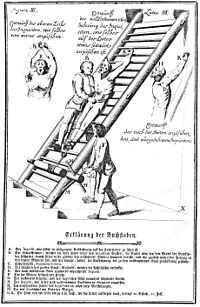Rack (torture)

The rack is a
Uses

Early use
It is unclear exactly from which civilization the rack originated, though some of the earliest examples are from Greece.[citation needed] The Greeks may have first used the rack as a means of torturing slaves and non-citizens, and later in special cases, as in 356 BC, when it was applied to gain a confession from Herostratus, an arsonist who was later executed for burning down the Temple of Artemis at Ephesus, one of the Seven Wonders of the Ancient World.[2] Arrian's Anabasis of Alexander states that Alexander the Great had the pages who conspired to assassinate him, along with their mentor, his court historian Callisthenes, tortured on the rack in 328 BC.[3]
According to
The rack was also used on early Christians, such as
Britain
Its first appearance in England is said to have been due to John Holland, 2nd Duke of Exeter, the constable of the Tower in 1447, and it was thus popularly known as "the Duke of Exeter's daughter".[1]
The Protestant martyr Anne Askew, daughter of Sir William Askew, Knight of Lincolnshire, was tortured on the rack before her execution in 1546 (age 25). She was well known for studying the Bible and memorizing verses; she remained apparently true to her beliefs even up to her execution. She was so damaged by the torture on the rack that she had to be carried on a chair to her burning at the stake. The accusations against her were from: (1) the Bishop's Chancellor Edmund Bonner, who claimed that women were not allowed to speak the Scriptures, and (2) the Bishop of Winchester Stephen Gardiner, because she would not profess that the sacraments were the literal flesh, blood and bone of Christ; this despite the fact that the English Reformation had already begun a decade earlier.[7]
The Catholic martyr Nicholas Owen, a noted builder of priest holes, died under torture on the rack in the Tower of London in 1606. Guy Fawkes is also thought to have been put to the rack, since a royal warrant authorising his torture survives. The warrant states that "lesser tortures" should be applied to him at first, but if he remained recalcitrant he could be racked.
In 1615 a clergyman called
In 1628 the question of its legality was raised in connection with a proposal in the
In 1679 Miles Prance, a silversmith who was being questioned about the murder of the respected magistrate Sir Edmund Berry Godfrey, was threatened with the rack.
Russia

In Russia up to the 18th century the rack (дыба, dyba) was a gallows-like device for suspending the victims (strappado). The suspended victims were whipped with a knout and sometimes burned with torches.[8]
See also
- Duke of Exeter's daughter
- Procrustes
- Strappado
- Breaking on the wheel
References
- ^ a b c d Chisholm, Hugh, ed. (1911). . Encyclopædia Britannica. Vol. 22 (11th ed.). Cambridge University Press. pp. 779–780.
- ISBN 978-1594865138.
- ^ The Anabasis of Arrian
- ^ The Annals by Tacitus (Section 15.57)
- ^ Lafaye, Georges [in French]. "Fidicula". In Daremberg, Charles Victor; Saglio, Edmond (eds.). Dictionnaire des Antiquités Grecques et Romaines. Vol. 1. Translated by Thayer, William P. p. 1117. Retrieved June 10, 2021 – via LacusCurtius.
Generally speaking, fidiculae are cited among instruments of torture next to the rack [EQUULEUS]. It must, until further notice, be considered likely that it was an assembly of ropes, which, by their arrangement, were more or less reminiscent of the lyre (fides, fidium).
- ^ The Letters of St. Jerome, Letter I, to Innocent, ¶ 3
- ^ Askew, Anne (1996). Beilin, Elaine V. (ed.). The Examinations of Anne Askew. New York: Oxford University Press.
- ^ Котошихин Г. К. О России, в царствование Алексея Михайловича. Современное сочинение Григория Котошихина. — СПб.: Археографическая комиссия, 1859.
Sources
- Monestier, M. (1994) Peines de mort. Paris, France: Le Cherche Midi Éditeur.
- Crocker, Harry W.; Triumph: The Power and Glory of the Catholic Church - A 2,000 Year History
